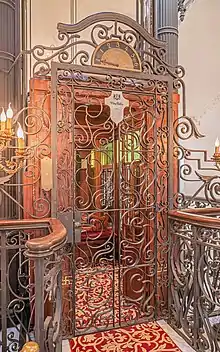Pera Palace Hotel
The Pera Palace Hotel (Turkish: Pera Palas Oteli) is a historic special category hotel and museum hotel located in the Beyoğlu (Pera) district in Istanbul, Turkey. It was built in 1892 for the purpose of hosting the passengers of the Orient Express and was named after the place where it is located. It holds the title of "the oldest European hotel of Turkey".


The Pera Palace Hotel is located in the Tepebaşı neighbourhood of Pera, once known as "Little Europe". It is about 20 km from Atatürk International Airport.
The hotel is in walking distance of Istiklal Avenue, Taksim Square and the British, Swedish, Russian, Dutch, Italian, French and German consulates.
The hotel was closed from 2006, undergoing a major renovation and restoration project and reopened on September 1, 2010.[1]
It was managed by Jumeirah Hotels as Pera Palace Hotel Jumeirah from 1 May 2012[2] to 2017.[3]
History


Establishment work began in 1892 and the grand opening ball was held in 1895.
Alexander Vallaury, a French-Turkish architect living in the city designed the hotel in a blend of neo-classical, art nouveau and oriental styles.[4] Vallaury undertook a number of other projects in Istanbul, including The Ottoman Bank Headquarters and The Istanbul Archaeology Museum.
The hotel was the first building in Turkey to be powered by electricity, other than the Ottoman Palaces.[5] It was also the only address in the city to provide hot running water for its guests and was home to the first electric elevator in Istanbul.[6]
The one of the first hotel's owners were the Ottoman Armenian Esayan family.[7]
Architecture and renovation

Pera Palace Hotel is today regarded as an important historical building and is listed under the general protection of Turkish Law (No. 2863 of 1983, amended with Law No. 5226 of 2004) concerning cultural heritage in Turkey.
The exterior façade, as well as the layout of the property, follows a neo-classical approach. The interiors of the building feature a more oriental style, mostly concentrated in the ballroom interior. In keeping with this eclectic vision, art nouveau lines feature in and around the elevator and in the coffee house section.
Although a prominent symbol of Istanbul’s cityscape, the Pera Palace property was in need of an extensive renovation. Consequently, in April 2008, the Beşiktas Shipping Group launched a Euro 23 million renovation and restoration project.[8] KA.BA Conservation of Historic Buildings and Architecture directed the project alongside the Metex Design Group and the entire renovation project is completed on September 1, 2010.[9]
A key attraction, the Atatürk Room 101 remains as a ‘Museum Room’, with many personal items and reading material of the Turkish nationalist leader Mustafa Kemal Atatürk exhibited to the public.
Literature and publications
- In Ernest Hemingway's short story The Snows of Kilimanjaro, the main character, writer Harry, stays at the Pera Palace hotel while serving in the military during the Allied occupation of Constantinople (Istanbul) in World War I.
- Henry Pulling and his aunt Augusta Bertram, protagonists of Graham Greene's 1969 novel, Travels With My Aunt, stay at the Pera Palace during their Istanbul adventure. The narrator Pulling is not enthusiastic about the quality of the food served.
- Detective writer Agatha Christie's 1934 novel Murder on the Orient Express was allegedly written in the Pera Palace Hotel in Istanbul, Turkey, the southern terminus of the railway. The hotel maintains Christie's room as a memorial to the author.
See also
References
- Official website
- https://hauteliving.com/2012/04/jumeirah-to-operate-pera-palace-hotel-in-istanbul/278053/
- https://famoushotels.org/hotels/pera-palace-hotel
- Batur, Afife; Üner, Göze (1 January 2005). Architectural guide to Istanbul. 2. Mimarlar Odası (Chamber of Architects of Turkey), Istanbul Metropolitan Branch. p. 33 – via Google Books.
- King, Charles (15 September 2014). Midnight at the Pera Palace: The Birth of Modern Istanbul. W. W. Norton & Company – via Google Books.
- Gaze's Tourists Gazette. Henry Gaze and Sons. 1 January 1900 – via Google Books.
- "Kayserili Ünlü Ermeniler" (in Turkish). Kayseri Surp Krikor Lusavoric Foundation. Archived from the original on 24 June 2012. Retrieved 31 January 2013.
- Yackley, Ayla Jean (3 September 2016). "Istanbul's Pera Palace Hotel restored to former glory". Reuters.
- Marcus, J. S. (20 February 2010). "Hammam Rejuvenation". The Wall Street Journal.
Further reading
- King, Charles. Midnight at the Pera Palace: The Birth of Modern Istanbul. New York: W. W. Norton & Company, 2014.
External links
| Wikimedia Commons has media related to Pera Palace Hotel. |